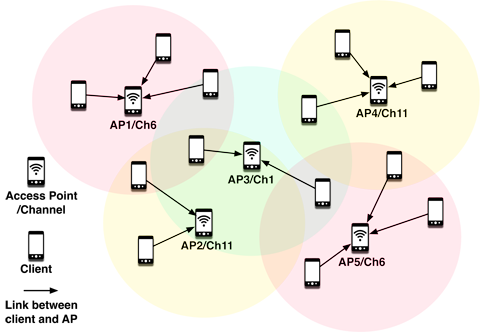Proceedings of the IEEE International Conference on Self-Adaptive and Self-Organizing Systems, pp. 247-256, 2013.

In forming opportunistic mobile ad-hoc networks, we propose to use infrastructure-mode WiFi instead of ad-hoc mode because:
- The infrastructure mode is available on many current mobile devices while the ad-hoc mode is not.
- It supports multiple channels (radio frequency bands), which can be used to reduce signal interference.
 |
In the infrastructure mode, each node may be an access point (AP) or a client.
Nodes can still form ad-hoc networks by having each client opportunistically connect to one of its nearby APs.
Unlike in the ad-hoc mode, however, nodes need to choose their roles to maximize communication,
and changing roles incurs overhead.
On the other hand, APs can choose their channels to avoid interference.
The proposed algorithm is excuted at each node based only on locally available information. It chooses AP/client roles, frequency (channel) when it has chosen to be an AP, and an AP to connect to among its nearby APs when it has chosen to be a client. |
Performance of the proposed algorithm, along with the (single-channel) ad-hoc mode and the previous work called WiFi-Opp, was measured and compared using the ONE opportunistic network simulator. A crowded room was simulated.
 |
 |
 |
The proposed algorithm outperforms the ad-hoc mode because it uses multiple (3 in this experiment) channels.
WiFi-Opp also performs better than the ad-hoc but not to the extent achieved by the proposed algorithm, as it does not involve adaptive channel or AP selection. |